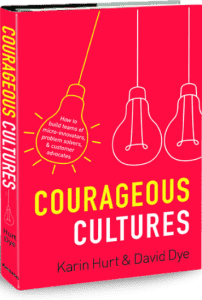It Takes Clarity and Curiosity to Encourage Creative Thinking
Businesses around the world face a changing normal, where it’s hard to say what things will look like in one year, much less six months from now. For some this means finding entirely fresh ways to bring value, for others it’s navigating a crush of demand, and many are trying to figure out how to maintain culture and productivity with a distributed, remote workforce. There are many challenges—and you need every solution to help you meet them. Finding ways to encourage creative thinking is vital to your success.
When we talk with leaders who wish their team were more creative, we often find that they unintentionally stifle creativity. With a few shifts in how you lead, you can cultivate a more creative environment and encourage creative thinking in your team.
7 Ways to Encourage Creative Thinking
1. Ask for what you want.
Creativity requires clarity. This type of direct approach may seem counter-intuitive, but it’s amazing what happens when you get everyone pointed in the right direction. It’s the difference between being given a blank sheet of paper and told to write a creative story vs asked to write a story about a shy rabbit who wants to meet the woodchuck on the other side of the fence. Even if you don’t think of yourself as creative, you could put together a story about that rabbit.
The same thing applies when you ask your team for their creative ideas. Rather than say, “We need everyone’s creativity and ideas to help us survive,” you might try:
“Our number one goal right now is to differentiate ourselves from our competitors and demonstrate value for our customers. We can’t do it the way we used to. This is where we need ideas. How can we add distinct value that our competitors can’t or won’t?”
2. Appreciate new ideas.
When someone comes up with a new idea that’s not quite ready, thank them, add information, and invite them to keep thinking. In Courageous Cultures we call this “Respond with Regard.”
For example, rather than say “We tried that last year” or “That won’t work because …” you might try: “Thanks so much for thinking about new ways we could try that. You know, last year we tried something similar, and we ran into this obstacle. Would you be willing to think about how we can overcome this obstacle?”
Or “I appreciate you thinking about this. Here’s some additional information that makes your suggestion challenging. I would love to hear your thoughts about how we can overcome this challenge or look at it differently.”
3. Reward effort, not just success.
You get more of what you encourage, less of what you ignore. Creativity requires risk-taking, so don’t limit encouragement and rewards to the ideas that work. Some ideas won’t work out, but you need all of them to find the ones that will. A fun example of rewarding effort is an annual award for “the best idea that didn’t work.”
4. Combine ideas and constraints.
Creativity is often a result of limitations. Try asking questions like “How can we … do x and y ?” where x is the idea and y is the constraint. For instance, someone asked, “How can we have a transportation company – without any fleet?” The answers of course are Uber and Lyft.
5. Start small.
Invite people to test their ideas with the smallest viable trial. This encourages people to try, rather than abandon ideas that “just might work,” but need refining. What did they learn? What would they do differently next time?
6. Don’t brainstorm.
Staring at a blank whiteboard and trying to offer ideas in a room or video conference with people of different power levels is a horrible way to be creative. Start with the first step on this list: ask for what you want. What will a successful solution do for your team or the customer? (You need this to evaluate creative options later.)
Then, rather than brainstorming, try alternatives like having everyone write three solutions on notecards. Scramble the notecards and redistribute. Have everyone write two ideas that build on the ideas they see on their card. Repeat. Then shuffle and have everyone share the ideas on their cards. Assess the ideas based on how well they potentially achieve the previously defined successful outcomes.
7. Create space.
We heard it again just last week while working with a team of talented and dedicated leaders. Some of them said, “It’s very hard for me to be creative when I’m put on the spot or in the moment. I’m much better if you can give me the problem or concept and let me think about it for a little while.”
In an interview for Courageous Cultures, Jason Fried, co-founder of Basecamp, explained that creative problem-solving “requires time to think, consider, and marinade. In most companies, there’s no time for that. Calendars are chock-full and leaders don’t understand that they’ve spread people too thin.”
Maximize creativity by creating space for it. Resist the urge to fill every minute with “productive” work – and be sure to model this yourself as well. If you say it, but don’t do it, your team will follow your example, not your words.
Your Turn
These seven steps will help you encourage creative thinking in your team—and they’re just a start. We’d love to hear from you. Leave us a comment and share your favorite way to encourage creative thinking and problem-solving.
 This article is based on our new book Courageous Cultures: How to Build Teams of Micro-Innovators, Problem Solvers, and Customer Advocates.
This article is based on our new book Courageous Cultures: How to Build Teams of Micro-Innovators, Problem Solvers, and Customer Advocates.
You can take our FREE Courageous Cultures quiz and receive a free chapter here, as well as learn about our pre-order bonuses.







0 Comments
Trackbacks/Pingbacks